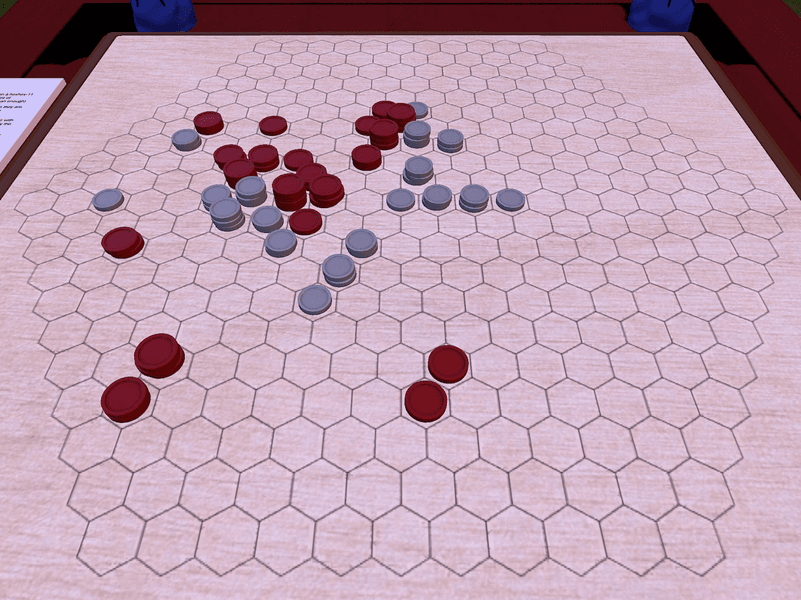Last week began a rather in-depth look into the development of a new game from Polish designer Michal Zapala.
The winner in Tumbleweed is the player that occupies the most spaces at the end of the game.
On a turn, you may settle a space by placing a stack of pieces on a space. The number of pieces in the placed stack is the number of spaces occupied by the player in the space’s line of sight. If the space is occupied, the stack С����Ƶ placed must be larger than the stack already occupying the space.
So the rules for the game played on a hex board are rather simple.
So, what in Zapala’s mind as designer is the best element of the game?
“Good question,” he replied. “Tumbleweed is a great and ongoing adventure. The community around it is growing slowly but surely, and I keep discovering new tactics and behaviors. Perhaps this in itself is the best thing of all: its ability to keep surprising me on all fronts.
“One thing I particularly like about it is the presence of stacks: I always liked this mechanics, and it’s put to good use here. The stack height almost feels like its ‘health points’: a very modern concept, yet it arises in a natural way and it serves a very classic territorial goal.”
But, what does the game offer others don’t?
“It’s always hard to compare one’s own game to others, let alone to all others,” offered Zapala. “I feel like the most irritating mistake a rookie designer can make is exclaiming: ‘his is the best game ever!’
“That said, I feel like Tumbleweed has a very unique, ‘syncretic’ aesthetic to it: precisely the reason why it can stand on its own and not compete with well-established classics.
“For instance, some games, like Chess or Draughts, are “piece focused”: your main consideration is the position of each particular piece. Others, like Go or mancala, are ‘group focused’: your main consideration are the groups of pieces and, in particular, each group lives or dies as a whole. Tumbleweed is both and neither: it’s largely (though not entirely) ‘piece focused’ in the opening and early middle game, but becomes more, though not entirely, ‘group focused’ towards the endgame.
“One of the players remarked that it feels “like a mix of Go and Amazons”, and there’s a grain of truth in that. Hearing this, one would expect an over complicated Frankenstein monster of a game, but no! – Tumbleweed has a very simple ruleset, and everything feels very natural once you start to play.
So far Tumbleweed exists online only, unless someone ‘bodgers’ a game together.
“Tumbleweed is a ‘quarantine child’: the ‘prototype’ was drawn in MS Paint, and all the playtesting was done online. So physical playability wasn’t my top priority, and it shows,” offered Zapala.
“Some people have tried playing it with poker chips, with mixed results: it’s somewhat hard to distinguish stack sizes. Another method is to use bulk dice instead of stacks, with number of pips signifying height.
“Either way, a Tumbleweed set isn’t very cheap to make, and the game take longer than in most commercially successful modern abstracts.
“So while I would love to see more over the board game and I feel like Tumbleweed deserves it, I wouldn’t expect any company to take the risk while it’s still largely unknown, and I have neither the resources nor skills to self-publish.
“For now, expanding the game’s online presence feels like the best way! I also like that it’s currently free to play.”
Zapala is putting some effort into online promotion of the game.
“So far, the game has largely spread by word of mouth,” he related.
“But for such a grassroots, noncommercial effort that’s not even half a year old, I feel like we’re in a good spot: apart from MindSports and IG Game Center, our main playing hub, Tumbleweed can be played on Ludii, SkudPaiSho.com, Tabletop Simulator and Ai Ai. There is a dozen or so active players, and around 20 more casual ones: it’s consistently rated as one of IGGC’s most popular positions, with a few games С����Ƶ played each day.
“But obviously I have appetite for more! We’d love to see the player base grow, and the game be implemented at more mainstream platforms.
“Ultimately, I’d love the Tumbleweed community to be a few hundred players strong, with a few local playing groups and regular tournaments. I believe this can be done, even in our over-saturated market: for instance, Nick Bentley’s Blooms only came out two years ago and it has over six thousand players.”
The next step will be a tourney.
“The most serious effort we’ve undertaken so far is planning a Tumbleweed tournament for this March, with cash prizes for new players: $100 for the best performance among newcomers, $50 for the runner up, and $20 for a randomly selected participant,” said Zapala. “We hope this will attract some new people. All these prizes are funded out of pocket by the current players, and I’m very touched by their commitment!
Check out Tumbleweeds on the game’s Facebook page.




